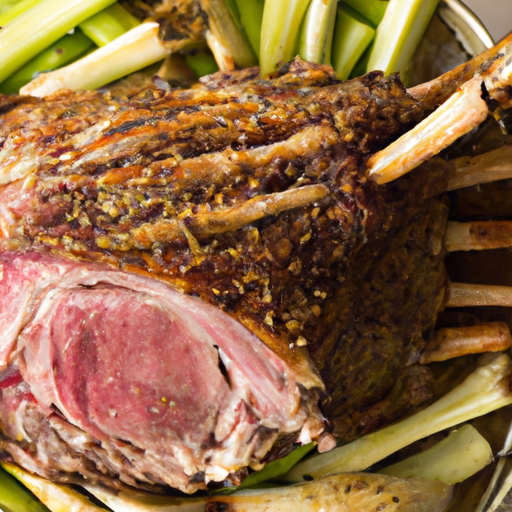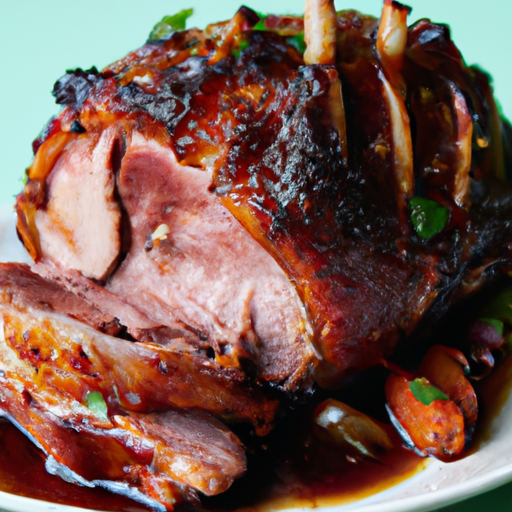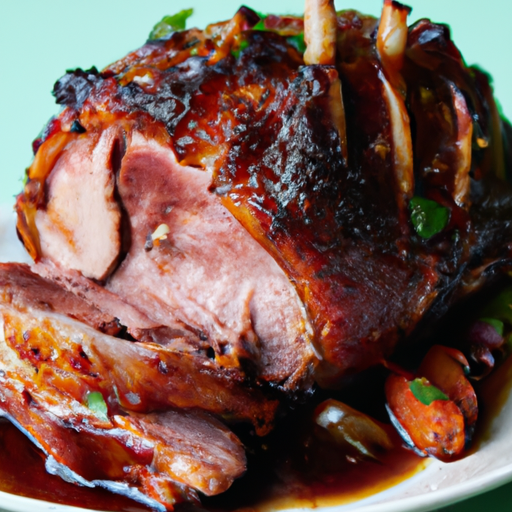If you’ve ever struggled with cooking a mouth-watering lamb roast, fear no more. “How to Perfectly Cook a Lamb Roast” is here to guide you through the process step by step. This comprehensive guide provides you with the cooking times and techniques needed to achieve that perfectly tender and flavorful lamb roast every time. Say goodbye to overcooked or undercooked roasts, and get ready to impress your friends and family with your culinary skills.
Preparing the Lamb Roast
When it comes to preparing a delicious lamb roast, there are several crucial steps to ensure a mouthwatering result. From selecting the right cut of lamb to allowing the roast to reach room temperature, each step plays a vital role in achieving perfection.

Selecting the Right Cut of Lamb
Choosing the right cut of lamb is the first and most important step in preparing a lamb roast. The ideal cut for roasting is the leg of lamb, which offers a tender and flavorful result. You can opt for a bone-in leg of lamb for added juiciness, or a boneless leg if you prefer ease of carving.
When selecting the leg of lamb, look for cuts that are well-marbled with fat, as this will enhance both the taste and tenderness of the roast. Additionally, ensure that the meat has a vibrant color and firm texture, avoiding any cuts with a strong odor or excessive discoloration.
Trimming and Seasoning the Roast
Before seasoning the roast, it is essential to trim any excess fat or silver skin from the leg of lamb. This will not only improve the appearance of the roast but also allow the flavors to penetrate the meat more effectively.
Once trimmed, generously season the lamb roast with your preferred spices and herbs. Popular choices include rosemary, thyme, garlic, salt, and pepper. Rub the mixture all over the roast, ensuring that it is evenly coated on all sides. This will infuse the meat with delectable flavors as it roasts.
Allowing the Roast to Reach Room Temperature
To achieve an evenly cooked lamb roast, it is crucial to allow the meat to reach room temperature before placing it in the oven. This ensures that the heat penetrates the meat more evenly, resulting in a juicier and tenderer roast.
Take the seasoned roast out of the refrigerator at least one hour before cooking time. This extra step will allow the lamb to lose its chill and bring it closer to room temperature. By doing so, you can minimize the risk of the roast being overcooked on the outside while undercooked on the inside.
Preheating the Oven
Properly preheating the oven is a critical step to ensure a well-cooked lamb roast. Both the temperature and the preparation of the roasting pan play integral roles in the overall outcome.
Choose the Appropriate Temperature
The recommended cooking temperature for a lamb roast depends on the desired level of doneness and the specific recipe you are following. As a general guideline, a temperature range between 325°F (160°C) and 375°F (190°C) can be used for most lamb roast recipes.
For a moist and tender roast, aim for a lower temperature around 325°F (160°C), which will result in slower cooking and a more evenly cooked interior. If you prefer a slightly crispier exterior, a higher temperature within the range of 375°F (190°C) will help achieve that.
Preparing the Roasting Pan
While the oven is preheating, take the time to prepare the roasting pan. Line the pan with aluminum foil to make cleanup easier and prevent any drippings from sticking to the bottom. Additionally, you can place a roasting rack in the pan to elevate the lamb roast, allowing for even air circulation and a more evenly browned exterior.
Roasting Techniques
The next step in cooking the perfect lamb roast is deciding which roasting technique to employ. Both the dry heat method and the moist heat method offer unique advantages and can be chosen based on personal preference and the desired outcome.
Using the Dry Heat Method
The dry heat method involves cooking the lamb roast uncovered, allowing the exterior to brown while sealing in the juices. This method is ideal for achieving a crispy and flavorful crust. To ensure the roast remains moist, it is essential to baste it periodically throughout the cooking process.
Using the Moist Heat Method
The moist heat method involves covering the lamb roast with a lid or foil while it cooks. This method creates a more tender and juicy result as the moisture is retained within the roasting pan. However, the trade-off may be a less crispy exterior compared to the dry heat method.
The choice between these two methods depends on personal preference and the desired taste and texture of the lamb roast. Experimentation and practice will help you determine which method works best for you.
Monitoring the Cooking Process
To avoid undercooking or overcooking the lamb roast, it is essential to monitor the cooking process carefully. By using a meat thermometer and regularly checking the internal temperature, you can ensure that the lamb roast is cooked to perfection.
Using a Meat Thermometer
A meat thermometer is an invaluable tool when it comes to roasting lamb. It allows you to accurately measure the internal temperature of the roast, ensuring that it reaches the desired level of doneness without overcooking.
Insert the meat thermometer into the thickest part of the roast, avoiding contact with any bones. Ensure that the thermometer is not touching the roasting pan or any fat, as this can give inaccurate readings. Leave the thermometer in place throughout the cooking process to monitor the temperature.
Checking the Internal Temperature Regularly
To achieve the perfect lamb roast, it is essential to check the internal temperature regularly. As the roast approaches the desired doneness level, keep a close eye on the thermometer readings to prevent overcooking.
Remember that the internal temperature of the lamb continues to rise slightly even after removing it from the oven. Therefore, it is advisable to remove the roast from the oven when the thermometer reads a few degrees below the target internal temperature, allowing for the residual heat to complete the cooking process.
Achieving the Perfect Internal Temperature
To ensure the lamb roast is cooked to perfection, it is essential to determine the desired doneness level and be aware of the corresponding internal temperatures.

Determining the Desired Doneness Level
The desired level of doneness depends on personal preference and the tastes of those you are serving. Whether you prefer your lamb roast rare, medium-rare, medium, or well-done, achieving the perfect internal temperature is key.
Target Internal Temperatures for Different Doneness Levels
For a rare lamb roast, aim for an internal temperature of 125°F (52°C). This will result in a deep pink or red center and a tender texture. If you prefer a medium-rare roast, cook until the internal temperature reaches 135°F (57°C). For a medium level of doneness with a slight hint of pink, aim for 145°F (63°C). Lastly, for a well-done roast with no trace of pink, cook until the internal temperature reaches 160°F (71°C) or higher.
Resting the Roast
Allowing the lamb roast to rest after cooking is a crucial step that should not be overlooked. Resting allows the juices to redistribute within the meat, resulting in a juicier and more flavorful roast.
Allowing the Roast to Rest
Once the lamb roast has reached the desired internal temperature, remove it from the oven and let it rest on a cutting board or serving platter. Tent the roast loosely with aluminum foil to retain heat, and let it rest for approximately 15-20 minutes. This resting period allows the meat fibers to relax and reabsorb the juices, ensuring a tender and succulent result.
Covering the Roast
While the roast is resting, it is advisable to cover it loosely with aluminum foil. This helps to retain the heat and prevent the roast from getting too cold. Additionally, covering the roast will allow the flavors to meld and enhance during the resting period, resulting in a more harmonious taste.
Carving and Serving
Carving and presenting the lamb roast is the final step before indulging in its deliciousness. With proper technique and attention to detail, you can showcase the roast in all its glory.
Carving the Roast
To carve the lamb roast, start by locating the natural seam that runs through the meat. Using a sharp carving knife, slice along the seam to separate the leg of lamb into individual servings. Cut thin, even slices against the grain, which will ensure tenderness and easy chewing.
If you are serving a bone-in leg of lamb, consider cutting the meat away from the bone first and then slicing it into portions. This method allows for easier handling and provides the option of serving both boneless and bone-in pieces.
Presenting the Lamb Roast
To present the lamb roast, arrange the carved slices on a platter or individual plates. Garnish with fresh herbs or a sprig of rosemary for an added touch of elegance. Serve alongside complementary dishes and accompaniments to create a well-balanced and memorable meal.
Accompaniments and Side Dishes
Choosing the perfect accompaniments and side dishes can elevate the flavors of your lamb roast and create a memorable dining experience. Consider these suggestions to complement the richness of the roast.
Choosing Complementary Flavors
When selecting accompaniments for your lamb roast, consider flavors that will balance and enhance the richness of the meat. Fresh herbs, such as mint, rosemary, or thyme, can provide a refreshing contrast. Additionally, tangy and acidic accompaniments like tzatziki sauce or a balsamic reduction can cut through the richness and add depth of flavor.
Suggested Side Dishes
A lamb roast pairs well with a variety of side dishes. Roasted potatoes, either seasoned simply or tossed in herbs and garlic, make for a classic and comforting choice. Steamed or grilled vegetables, like asparagus or green beans, can provide a vibrant and fresh element to the meal. Consider serving a grain-based salad, like couscous or quinoa, for added texture and nutritional value.
Troubleshooting and Tips
To ensure a successful lamb roast, it is essential to be aware of common mistakes to avoid and implement useful tips for a fantastic outcome.
Common Mistakes to Avoid
One common mistake when roasting lamb is overcooking, which can result in dry and tough meat. Regularly monitoring the internal temperature with a meat thermometer can help prevent this. Another mistake is not allowing the meat to rest after cooking, which can cause the juices to run out when carving. Lastly, neglecting to season the roast adequately can lead to a lack of flavor in the finished product.
Tips for a Successful Lamb Roast
To achieve a successful lamb roast, consider the following tips:
- Invest in a high-quality meat thermometer to accurately monitor the internal temperature.
- Take the time to properly trim and season the roast, ensuring maximum flavor penetration.
- Allow the roast to reach room temperature before cooking for even cooking throughout.
- Preheat the oven to the appropriate temperature to ensure the desired level of doneness.
- Rest the roast after cooking to allow the juices to redistribute and enhance the tenderness.
- Experiment with different herbs, spices, and marinades to enhance the flavors of the lamb roast.
Variations and Flavor Enhancements
To add variety and enhance the flavors of your lamb roast, consider experimenting with different marinades, rubs, and herb and spice combinations.
Marinades and Rubs
Marinating the lamb roast before cooking can infuse it with additional flavors and tenderize the meat. Traditional marinades often feature a combination of garlic, lemon juice, olive oil, and herbs, such as rosemary and thyme. Alternatively, dry rubs consisting of a blend of spices, like cumin, coriander, and paprika, can provide a bold and aromatic crust.
Herb and Spice Combinations
Herbs and spices are a fantastic way to enhance the flavors of your lamb roast. Classic combinations include rosemary and garlic, which impart a savory and aromatic profile. For a Middle Eastern twist, consider combining cumin, coriander, and cinnamon for a warm and exotic flavor. Additionally, fresh mint can add a refreshing and vibrant element to the overall taste.
By exploring different variations and flavor enhancements, you can create a lamb roast that reflects your unique culinary preferences and delights your taste buds.
In conclusion, preparing a lamb roast is a rewarding endeavor that requires attention to detail and a passion for creating a delicious meal. Starting with the right cut of lamb, trimming and seasoning the roast, and allowing it to reach room temperature are essential steps in the process. Preheating the oven at the appropriate temperature and preparing the roasting pan adequately are crucial for a successful outcome. Choosing between the dry heat method and the moist heat method, monitoring the cooking process with a meat thermometer, and achieving the perfect internal temperature contribute to a perfectly cooked lamb roast. Allowing the roast to rest, carving and presenting it, and selecting complementary accompaniments and side dishes further enhance the dining experience. By troubleshooting common mistakes, following useful tips, and exploring variations and flavor enhancements, you can elevate your lamb roast to a culinary masterpiece. So roll up your sleeves, gather your ingredients, and get ready to enjoy a succulent and flavorful lamb roast that will impress your friends and family. Happy cooking!
